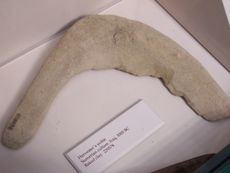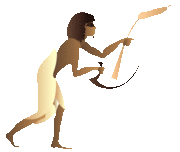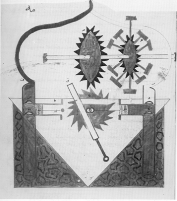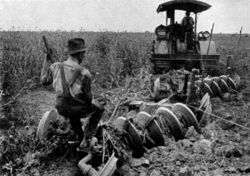History of agriculture
2008/9 Schools Wikipedia Selection. Related subjects: History
| Agriculture |
|---|
 |
| General |
| Agribusiness · Agriculture Agricultural science · Agronomy |
| History |
| History of agriculture Neolithic Revolution |
| Particular |
| Aquaculture · Christmas trees · Dairy farming Grazing · Hydroponics · IMTA |
| Categories |
| Agriculture by country Agriculture companies |
Agriculture was developed at least 10,000 years ago, and it has undergone significant developments since the time of the earliest cultivation. Evidence points to the Fertile Crescent of the Middle East as the site of the earliest planned sowing and harvesting of plants that had previously been gathered in the wild. Independent development of agriculture occurred in northern and southern China, Africa's Sahel, New Guinea and several regions of the Americas. Agricultural practices such as irrigation, crop rotation, fertilizers, and pesticides were developed long ago but have made great strides in the past century. The Haber-Bosch method for synthesizing ammonium nitrate represented a major breakthrough and allowed crop yields to overcome previous constraints. In the past century agriculture has been characterized by enhanced productivity, the substitution of labor for synthetic fertilizers and pesticides, selective breeding, mechanization, water pollution, and farm subsidies. In recent years there has been a backlash against the external environmental effects of conventional agriculture, resulting in the organic movement.
Origins

Identifying the exact origin of agriculture remains problematic because the transition from hunter-gatherer societies began thousands of years before the invention of writing. Nonetheless, archaeobotanists/ paleoethnobotanists have traced the selection and cultivation of specific food plant characteristics, such as a semi-tough rachis and larger seeds, to just after the Younger Dryas (about 9,500 BC) in the early Holocene in the Levant region of the Fertile Crescent. There is earlier evidence for use of wild cereals: anthropological and archaeological evidence from sites across Southwest Asia and North Africa indicate use of wild grain (e.g., from the ca. 20,000 BC site of Ohalo II in Israel, many Natufian sites in the Levant and from sites along the Nile in the 10th millennium BC). There is even evidence of planned cultivation and trait selection: grains of rye with domestic traits have been recovered from Epi-Palaeolithic (10,000+ BC) contexts at Abu Hureyra in Syria, but this appears to be a localised phenomenon resulting from cultivation of stands of wild rye, rather than a definitive step towards domestication. It isn't until after 9,500 BC that the eight so-called founder crops of agriculture appear: first emmer and einkorn wheat, then hulled barley, peas, lentils, bitter vetch, chick peas and flax. These eight crops occur more or less simultaneously on PPNB sites in the Levant, although the consensus is that wheat was the first to be sown and harvested on a significant scale.
Mehrgarh, one of the most important Neolithic (7000 BCE to 3200 BCE) sites in archaeology, lies on the "Kachi plain of Baluchistan, Pakistan, and is one of the earliest sites with evidence of farming (wheat and barley) and herding (cattle, sheep and goats) in South Asia."{{fact|November 2007}
By 7000 BC, sowing and harvesting reached Mesopotamia and there, in the super fertile soil just north of the Persian Gulf, Sumerian ingenuity systematized it and scaled it up. By 6000 BC farming was entrenched on the banks of the Nile River. About this time, agriculture was developed independently in the Far East, probably in China, with rice rather than wheat as the primary crop. Maize was first domesticated, probably from teosinte, in the Americas around 3000-2700 BC, though there is some archaeological evidence of a much older development. The potato, the tomato, the pepper, squash, several varieties of bean, and several other plants were also developed in the New World, as was quite extensive terracing of steep hillsides in much of Andean South America. Agriculture was also independently developed on the island of New Guinea.
In China, rice and millet were domesticated by 8000 BC, followed by the beans mung, soy and azuki. In the Sahel region of Africa local rice and sorghum were domestic by 5000 BC. Local crops were domesticated independently in West Africa and possibly in New Guinea and Ethiopia. Evidence of the presence of wheat and some legumes in the 6th millennium BC have been found in the Indus Valley. Oranges were cultivated in the same millennium. The crops grown in the valley around 4000 BC were typically wheat, peas, sesame seed, barley, dates and mangoes. By 3500 BC cotton growing and cotton textiles were quite advanced in the valley. By 3000 BC farming of rice had started. Other monsoon crops of importance of the time was cane sugar. By 2500 BC, rice was an important component of the staple diet in Mohenjodaro near the Arabian Sea. By this time the Indians had large cities with well-stocked granaries. Three regions of the Americas independently domesticated corn, squashes, potato and sunflowers.
Theory
The reasons for the development of farming may have included climate change, but possibly there were also social reasons (e.g., accumulation of food surplus for competitive gift-giving as in the Pacific Northwest potlatch culture). Most likely there was a gradual transition from hunter-gatherer to agricultural economies after a lengthy period during which some crops were deliberately planted and other foods were gathered in the wild. Although localised climate change is the favoured explanation for the origins of agriculture in the Levant, the fact that farming was 'invented' at least three times elsewhere, and possibly more, suggests that social reasons may have been instrumental.
When major climate change took place after the last ice age c.11,000 BC much of the earth became subject to long dry seasons. These conditions favoured annual plants which die off in the long dry season, leaving a dormant seed or tuber. These plants tended to put more energy into producing seeds than into woody growth. An abundance of readily storable wild grains and pulses enabled hunter-gatherers in some areas to form the first settled villages at this time.
There are several theories as to what drove populations to take up agriculture:
- The Oasis Theory which was original proposed by Raphael Pumpelly in 1908, but popularized by Vere Gordon Childe in 1928 and summarised in his book Man Makes Himself This theory maintains that as the climate got drier, communities contracted to oases where they were forced into close association with animals which were then domesticated together with planting of seeds. It has little support now as the climate data for the time does not support the theory.
- The Hilly Flanks hypothesis. Proposed by Robert Braidwood in 1948, it suggests that agriculture began in the hilly flanks of the Taurus and Zagros mountains, and that it developed from intensive focused grain gathering in the region.
- The Feasting model by Bryan Hayden suggests that agriculture was driven by ostentatious displays of power, such as throwing feasts to exert dominance. This required assembling large quantities of food which drove agricultural technology.
- The Demographic theories proposed by Carl Sauer and adapted by Lewis Binford and Kent Flannery. This leads from an increasingly sedentary population, expanding up to the carrying capacity of the local environment, and requiring more food than can be gathered. Various social and economic factors help drive the need for food.
- The evolutionary/intentionality theory. As proposed by those such as David Rindos the idea that agriculture is an evolutionary adaptation of plants and humans. Starting with domestication by protection of wild plants, followed specialisation of location and then domestication.
Ancient agriculture

Source: http://www.kingtutone.com
By the Bronze Age, wild food contributed a nutritionally insignificant component to the usual diet. If the operative definition of agriculture includes large scale intensive cultivation of land, mono-cropping, organized irrigation, and use of a specialized labour force, the title "inventors of agriculture" would fall to the Sumerians, starting ca. 5,500 BC. Intensive farming allows a much greater density of population than can be supported by hunting and gathering, and allows for the accumulation of excess product for off-season use, or to sell/barter. The ability of farmers to feed large numbers of people whose activities have nothing to do with agriculture was the crucial factor in the rise of standing armies. Sumerian agriculture supported a substantial territorial expansion which along with internecine conflict between cities, made them the first empire builders. Not long after, the Egyptians, powered by farming in the fertile Nile valley, achieved a population density from which enough warriors could be drawn for a territorial expansion more than tripling the Sumerian empire in area.
Sumerian agriculture
In Sumer, barley was the main crop, but wheat, flax, dates, apples, plums, and grapes were grown as well. Mesopotamia was blessed with flooding from the Tigris and Euphrates rivers but floods came in late spring or early summer from snow melting from the Turkish mountains. With Salt deposits under the soil, all of this made Mesopotamia very hard to farm. The earliest known sheep and goats were also domesticated and were in a much larger quantity than cattle. Sheep were mainly kept for meat and milk, and butter and cheese were made from the latter. Ur, a large town that covered about 50 acres (20 hectares), had 10,000 animals kept in sheepfolds and stables and 3,000 slaughtered every year. The city's population of 6,000 included a labour force of 2,500 cultivated 3,000 acres (12 km²) of land. The labour force contained storehouse recorders, work foremen, overseers, and harvest supervisors to supplement labourers. Agricultural produce was given to temple personnel, important people in the community, and small farmers.
The land was plowed by teams of oxen pulling light unwheeled plows and grain was harvested with sickles in the spring. Wagons had solid wheels covered by leather tires kept in position by copper nails and were drawn by oxen and the Syrian onager (now extinct). Animals were harnessed by collars, yokes, and headstalls. They were controlled by reins, and a ring through the nose or upper lip and a strap under the jaw. As many as four animals could pull a wagon at one time. Though some hypothesize that Domestication of the horse occurred as early as 4000 BC in the Ukraine, the horse was definitely in use by the Sumerians around 2000 BC.
Chinese agriculture
The unique tradition of Chinese agriculture has been traced to the pre-historic Xianrendong Relics and Diaotonghuan Relics (c. 12 0000 BC- 7500 BC). Chinese historical and governmental records of the Warring States ( 481 BC- 221 BC), Qin Dynasty ( 221 BC- 207 BC), and Han Dynasty ( 202 BC- 220 AD) eras allude to the use of complex agricultural practices, such as a nationwide granary system and widespread use of sericulture. However, the oldest extant Chinese book on agriculture is the Chimin Yaoshu of 535 AD, written by Jia Sixia. Although much of the literature of the time was elaborate, flowery, and allusive, Jia's writing style was very straightforward and lucid, a literary approach to agriculture that later Chinese agronomists after Jia would follow, such as Wang Zhen and his groundbreaking Nong Shu of 1313 AD. Jia's book was also incredibly long, with over one hundred thousand written Chinese characters, and quoted 160 other Chinese books that were written previously (but no longer survive). The contents of Jia's 6th century book include sections on land preparation, seeding, cultivation, orchard management, forestry, and animal husbandry. The book also includes peripherally related content covering trade and culinary uses for crops.
For agricultural purposes, the Chinese had innovated the hydraulic-powered trip hammer by the 1st century BC. Although it found other purposes, its main function to pound, decorticate, and polish grain that otherwise would have been done manually. The Chinese also innovated the square-pallet chain pump by the 1st century AD, powered by a waterwheel or an oxen pulling a on a system of mechanical wheels. Although the chain pump found use in public works of providing water for urban and palatial pipe systems, it was used largely to lift water from a lower to higher elevation in filling irrigation canals and channels for farmland.
Indian agriculture
Evidence of the presence of wheat and some legumes in the 6th millennium BCE have been found in the Indus Valley. Oranges were cultivated in the same millennium. The crops grown in the valley around 4000 BCE were typically wheat, peas, sesame seed, barley, dates and mangoes. By 3500 BCE cotton growing and cotton textiles were quite advanced in the valley. By 3000 BCE farming of rice had started. Other monsoon crops of importance of the time was cane sugar. By 2500 BCE, rice was an important component of the staple diet in Mohenjodaro near the Arabian Sea.
The Indus Plain had rich alluvial deposits which came down the Indus River in annual floods. This helped sustain farming that formed basis of the Indus Valley Civilization at Harappa. The people built dams and drainage systems for the crops.
By 2000 BCE tea, bananas and apples were being cultivated in India. There was coconut trade with East Africa in 200 BCE. By 500 CE, eggplants were being cultivated.
Roman agriculture
Roman agriculture built off techniques pioneered by the Sumerians, with a specific emphasis on the cultivation of crops for trade and export. Romans laid the groundwork for the manorial economic system, involving serfdom, which flourished in the Middle Ages.
Mesoamerican agriculture
In Mesoamerica, the Aztecs were some of the most innovative farmers of the ancient world and farming provided the entire basis of their economy. The land around Lake Texcoco was fertile but not large enough to produce the amount of food needed for the population of their expanding empire. The Aztecs developed irrigation systems, formed terraced hillsides, and fertilized their soil. However, their greatest agricultural technique was the chinampa or artificial islands also known as "floating gardens". These were used to make the swampy areas around the lake suitable for farming. To make chinampas, canals were dug through the marshy islands and shores, then mud was heaped on huge mats made of woven reeds. The mats were anchored by tying them to posts driven into the lake bed and then planting trees at their corners that took root and secured the artificial islands permanently. The Aztecs grew corn, squash, vegetables, and flowers on chinampas.
Andean agriculture
The Andean civilizations were predominantly agricultural societies; the Incas took advantage of the ground, conquering the adversities like the Andean area and the inclemencies of the weather. The adaptation of agricultural technologies that already were used previously, allowed the Incas to organize the production a diversity of products of the coast, mountain and jungle, so them could be able to redistribute to villages that did not have access to other regions. The technological achievements reached to agricultural level, had not been possible without the workforce that was at the disposal of the Sapa Inca, as well as the road system that was allowing to store adequately the harvested resources and to distribute them for all the territory.
Muslim Agricultural Revolution

From the 8th century, the medieval Islamic world witnessed a fundamental transformation in agriculture known as the " Muslim Agricultural Revolution", "Arab Agricultural Revolution", or " Green Revolution". Due to the global economy established by Muslim traders across the Old World during the " Afro-Asiatic age of discovery" or "Pax Islamica", this enabled the diffusion of many crops, plants and farming techniques between different parts of the Islamic world, as well as the adaptation of crops, plants and techniques from beyond the Islamic world, distributed throughout Islamic lands which normally would not be able to grow these crops. These techniques included crop rotation, irrigation and pest control. Some have referred to the diffusion of numerous crops during this period as the "Globalisation of Crops" ,which, along with increased mechanization of agriculture, led to major changes in economy, population distribution, vegetation cover, agricultural production and income, population levels, urban growth, the distribution of the labour force, linked industries, cooking and diet, clothing, and numerous other aspects of life in the Islamic world.
Serfdom became widespread in eastern Europe in the Middle Ages. Medieval Europe owed much of its development to advances made in Islamic areas, which flourished culturally and materially while Europe and other Roman and Byzantine administered lands entered an extended period of social and economic stagnation. As early as the ninth century, an essentially modern agricultural system became central to economic life and organization in the Arab caliphates, replacing the largely export driven Roman model. The great cities of the Near East, North Africa and Moorish Spain were supported by elaborate agricultural systems which included extensive irrigation based on knowledge of hydraulic and hydrostatic principles, some of which were continued from Roman times. In later centuries, Persian Muslims began to function as a conduit, transmitting cultural elements, including advanced agricultural techniques, into Turkic lands and western India. The Muslims introduced what was to become an agricultural revolution based on four key areas:
- Development of a sophisticated system of irrigation using machines such as norias, water mills, water raising machines, dams and reservoirs. With such technology they managed to greatly expand the exploitable land area.
- The adoption of a scientific approach to farming enabled them to improve farming techniques derived from the collection and collation of relevant information throughout the whole of the known world. Farming manuals were produced in every corner of the Muslim world detailing where, when and how to plant and grow various crops. Advanced scientific techniques allowed leaders like Ibn al-Baytar to introduce new crops and breeds and strains of livestock into areas where they were previously unknown.
- Incentives based on a new approach to land ownership and labourers' rights, combining the recognition of private ownership and the rewarding of cultivators with a harvest share commensurate with their efforts. Their counterparts in Europe struggled under a feudal system in which they were almost slaves ( serfs) with little hope of improving their lot by hard work.
- The introduction of new crops transforming private farming into a new global industry exported everywhere, including Europe, where farming was mostly restricted to wheat strains obtained much earlier via central Asia. Spain received what she in turn transmitted to the rest of Europe; many agricultural and fruit-growing processes, together with many new plants, fruit and vegetables. These new crops included sugar cane, rice, citrus fruit, apricots, cotton, artichokes, aubergines, and saffron. Others, previously known, were further developed. Muslims also brought to that country lemons, oranges, cotton, almonds, figs and sub-tropical crops such as bananas and sugar cane. Several were later exported from Spanish coastal areas to the Spanish colonies in the New World. Also transmitted via Muslim influence, a silk industry flourished, flax was cultivated and linen exported, and esparto grass, which grew wild in the more arid parts, was collected and turned into various articles.
Agriculture in the Middle Ages
During the Middle Ages, Muslim farmers in North Africa and the Near East developed and disseminated agricultural technologies including irrigation systems based on hydraulic and hydrostatic principles, the use of machines such as norias, and the use of water raising machines, dams, and reservoirs. They also wrote location-specific farming manuals, and were instrumental in the wider adoption of crops including sugar cane, rice, citrus fruit, apricots, cotton, artichokes, aubergines, and saffron. Muslims also brought lemons, oranges, cotton, almonds, figs and sub-tropical crops such as bananas to Spain.
Renaissance agriculture
The invention of a three field system of crop rotation during the Middle Ages, and the importation of the Chinese-invented moldboard plow, vastly improved agricultural efficiency.
After 1492 the world's agricultural patterns were shuffled in the widespread exchange of plants and animals known as the Columbian Exchange. Crops and animals that were previously only known in the Old World were now transplanted to the New and vice versa. Perhaps most notably, the tomato became a favorite in European cuisine, and maize and potatoes were widely adopted. Other transplanted crops include pineapple, cocoa, and tobacco. In the other direction, several wheat strains quickly took to western hemisphere soils and became a dietary staple even for native North, Central and South Americans.
Agriculture was a key element in the Atlantic slave trade, Triangular trade, and the expansion by European powers into the Americas. In the expanding Plantation economy, large plantations producing crops including sugar, cotton, and indigo, were heavily dependent upon slave labor.
British Agricultural Revolution
Between the 16th century and the mid-19th century, Great Britain saw a massive increase in agricultural productivity and net output. New agricultural practices like enclosure, mechanization, four-field crop rotation and selective breeding enabled an unprecedented population growth, freeing up a significant percentage of the workforce, and thereby helped drive the Industrial Revolution.
By the early 1800s, agricultural practices, particularly careful selection of hardy strains and cultivars, had so improved that yield per land unit was many times that seen in the Middle Ages and before.
The 18th and 19th century also saw the development of glasshouses, or greenhouses, initially for the protection and cultivation of exotic plants imported to Europe and North America from the tropics.
Experiments on Plant Hybridization in the late 1800s yielded advances in the understanding of plant genetics, and subsequently, the development of hybrid crops.
Increasing dependence upon monoculture crops lead to famines and food shortages, most notably the Irish Potato Famine (1845–1849).
Storage silos and grain elevators appeared in the 19th centuries.
Recent history
New technologies
With the rapid rise of mechanization in the late 19th and 20th centuries, particularly in the form of the tractor, farming tasks could be done with a speed and on a scale previously impossible. These advances, joined to science-driven innovations in methods and resources, have led to efficiencies enabling certain modern farms in the United States, Argentina, Israel, Germany and a few other nations to output volumes of high quality produce per land unit at what may be the practical limit.
The development of rail and highway networks and the increasing use of container shipping and refrigeration in developed nations have also been essential to the growth of mechanized agriculture, allowing for the economical long distance shipping of produce.
While chemical fertilizer and pesticide have existed since the 19th century, their use grew significantly in the early twentieth century. In the 1960s, the Green Revolution applied western advances in fertilizer and pesticide use to farms worldwide, with varying success.
Other applications of scientific research since 1950 in agriculture include gene manipulation, and Hydroponics.
New criticisms
Though the intensive farming practices pioneered and extended in recent history generally led to increased outputs, they have also led to the destruction of farmland, most notably in the dust bowl area of the United States following World War I.
As global population increases, agriculture continues to replace natural ecosystems with monoculture crops.
In the past few decades, western consumers have become increasingly aware of, and in some cases critical of, widely used intensive agriculture practices, contributing to a rise in popularity of organic farming, the growth of the Slow Food movement, and an ongoing discussion surrounding the potential for sustainable agriculture.
Agricultural revolutions
- Neolithic Revolution
- Muslim Agricultural Revolution
- British Agricultural Revolution
- Green Revolution
